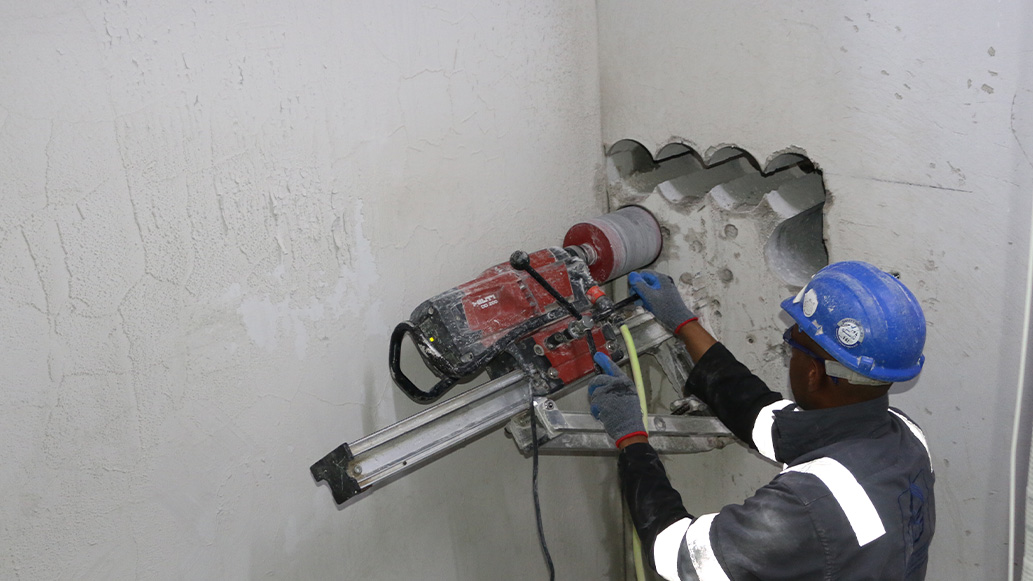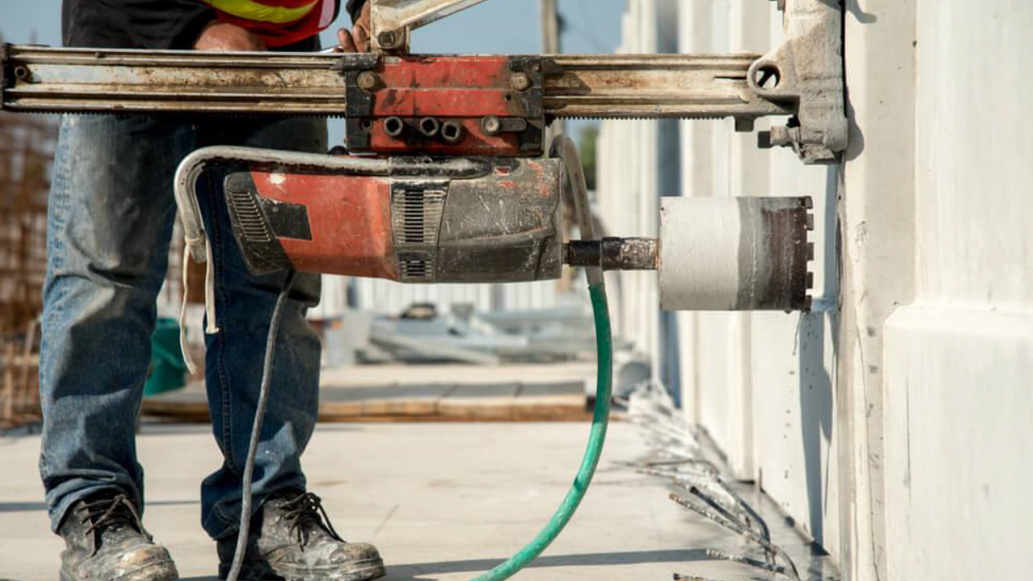 Share
Share


Diamond core drilling is a popular technique for holes into concrete. Downward pressure and high rotation and advanced drill bits are faced with diamond-impregnated steel.
For pipes, wires ventilating systems, or air-conditioning vents for fit through coring are used however in order to avoid cutting through reinforcement, core cutting must be carefully planned.
Another purpose of coring is to obtain an undisturbed, intact sample representative of the concrete. What does core/drilling serve? Getting an undamaged, undisturbed sample that is typical of the in-situ material is the main goal of core drilling or opening the circular shape.
A core/drill is a hollow, cylindrical drill that is used to do holes through a surface. … To make the hole, it twists and pushes through the surface. For the greatest performance, a different drill bit needs to be installed for each surface. While doing coring it will cut all the structure inside the core bit and it’s used from small to big circular, however, the drilling is used only for the small diameter, and it doesn’t have the ability to cut the steel inside the concrete.
Assembling and installing the coring machine with various core bit sizes as needed first, then anchoring to the base of the machine using unfix. Check for appropriate installation and operation of the coring machine before assembling and installing the drive unit if needed. Start the concrete coring process in accordance with the markings and run water continually to maintain the core bit cool at all times. The cored material or waste typically remains inside the bit's barrel, where it can be quickly and safely removed.
Similar to drilling, concrete coring employs a large, rounded cutting tool at the drill’s end as opposed to a small drill bit. This cutting device drills a significantly deeper hole than a drill through concrete.
The procedure is non-percussive, low-noise, and dust-free. It is without a doubt the most often used option for core, cutting concrete. For drilling in delicate areas or restricted spaces, a range of electric or hydraulic rigs can be employed. Holes can be cored at any angle, whether vertical or horizontal.
Never employ hammer action for core drilling, as we have previously stated but will do it again. The drilling process must be as fluid as possible because a jerky hammer stroke can easily snap pricey diamond teeth.
Core drilling may create holes with a diameter of up to 40 cm, starting at two-fourth of an inch. The depths can go down to 3 or a bit more.
Concrete drill bits can be attached to electrical or hydraulic core drills in sizes ranging from less than an inch to a typical maximum of 40 cm. Drilling can be done from zero to any 3 meters or bit more required to finish the operation properly.
The setup, leveling, and cleaning, and fixing processes take 20 -25 minutes, while the actual coring procedure takes around 20 – 30 minutes depending on the diameter of the hole, strength, and depth of the concrete. To put things into perspective, cutting a rectangular concrete slab with an 18.85′′ linear edge is equivalent to core-drilling a 6′′ hole. It’s a substantial cut. Cop Tool has further information about this.
A rotary drill with a diamond drill bit attached is used in the core drilling technique known as diamond drilling to produce precisely sized holes. Diamond is the world’s hardest naturally occurring substance, making it perfect for cutting apertures in a variety of materials like glass, metal, and concrete.
Core drilling, which dates back to 3000 BC and is still in use, was created by the ancient Egyptians. We’ll go through the two primary coring techniques, how they operate, and the most typical uses for each in this post.
You can use it for that, provided you go slowly and give the drill a break every few minutes. must hammer off, drill the pilot first, and regularly cleanout.
Filters. (obsolete) to adorn; to embellish. verb. to take the core out of. to crack the cabbage.
As the name implies, dry core bits can be utilized without water, whereas wet bits need water cooling to function. While using dry bits is more practical and user-friendly for DIYS but its a costly process mainly in furnished places, it frequently lacks the drilling strength of wet core bits.
Hammer drills are better for smaller operations since they are more portable and compact than diamond core rigs. Because cheaper bits cannot survive the force of the impact produced by a hammer drill, percussion carbide bits are most frequently utilized with hammer drills. A hammer drill can be used to drill small holes in diameter.
Universal motors are also used in routers, electric drills, and vacuum cleaners. The brushes on these motors rub on the slotted armature, which is why they make so much noise. Additionally, gear train noise is present in drills and circular saws. Universal motors are used by manufacturers because they are lighter and smaller than induction motors.
In RC drilling, hard rock and dirt are cut with drill bits that have spherical, projecting tungsten-carbide buttons. Water can be injected during collaring a new hole to help lift cuttings to the surface and prevent dust even though the process itself is normally dry.
Each drilling method provides for a different kind of sample. While RC drilling is effective for obtaining bulk samples, diamond core drilling is good for accurate layer sampling and analysis. The rate of drilling can be affected by the surface conditions, but RC drilling is frequently much faster than diamond core drilling.
The coring machine will be put together and installed with different core bit sizes as necessary, and then it will be anchored to the machine’s foundation using unfix. Before assembling and installing the drive unit, if necessary, make sure the coring machine is installed and operating properly. Start coring the concrete according to the markings, and keep the core bit cool at all times by running water continuously. Usually, the waste or cored material is left inside the bit’s barrel, where it can be retrieved swiftly and safely.
